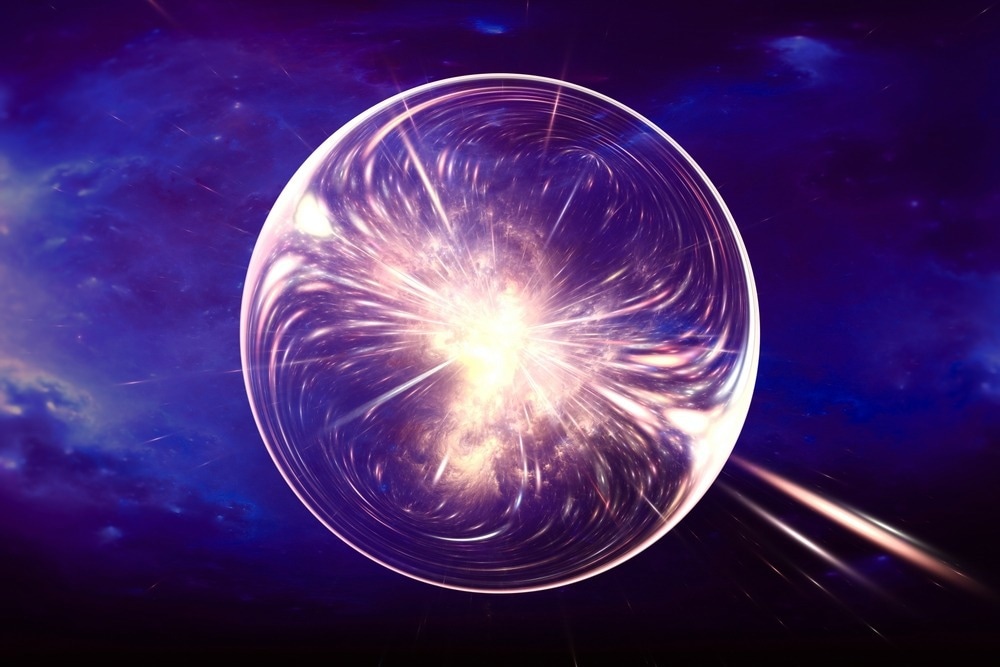A crucial turning point in particle physics occurred in 2012 when the Higgs Boson was discovered at CERN's Large Hadron Collider (LHC). Since that time, the ATLAS and CMS teams have been meticulously examining the characteristics of this unusual particle and trying to determine the various ways in which it is created and degrades into other particles.

Image Credit: Jurik Peter/Shutterstock.com
The Higgs boson's rare decay into a photon and a Z boson was reported for the first time by ATLAS and CMS at the Large Hadron Collider Physics (LHCP) recently. The Z boson is an electrically neutral particle associated with the weak force while the photon is the carrier of electromagnetic radiation.
Experiments at CERN
ATLAS is an all-purpose experiment for particle physics at CERN's Large Hadron Collider (LHC). A global team of physicists, engineers, technicians, students, and support personnel collaborated on it. By pursuing answers to basic problems, ATLAS' study pushes the boundaries of knowledge through precision measurement.
At the Large Hadron Collider (LHC), the Compact Muon Solenoid (CMS) is a general-purpose detector. Its extensive physics curriculum includes everything from investigating the Higgs boson and other components of the Standard Model of particle physics to looking for additional dimensions and particles that might comprise dark matter.
CERN Leads Pioneering Dark Matter Research NA64
Indirect proof of the existence of particles other than those predicted by the Standard Model may be offered by the newly observed Higgs boson decay.
Similar to a decay into two photons, the Higgs boson can decay into a photon and Z Boson. The Higgs boson does not directly decay into photons and Z Bosons. Instead, the decay takes place through a middle "loop" of "virtual" particles that appear and disappear but cannot be directly observed. There may be new, as of yet unidentified particles in these virtual particles that may interact with the Higgs boson.
The Standard Model
Three of the four known forces in nature—the electromagnetic force, the weak nuclear force, and the strong nuclear force—are covered by the Standard Model, a theory in particle physics.
0.15% of Higgs bosons are predicted to decay into a photon and a Z boson, according to the Standard model, if the Higgs boson has a mass of about 125 billion electron volts. However, other models that go beyond the Standard Model forecast a different rate of degradation. The nature of the Higgs boson and the physics beyond the Standard Model can both be learned from measuring the decay rate.
Previously, ATLAS and CMS independently carried out in-depth searches for the Higgs boson's disintegration into a photon and a Z boson using data from proton-proton collisions at the LHC. Similar methods were employed by both studies to pinpoint the Z boson's decay into electrons or muons, which are heavier counterparts of electrons. In 6.6% of situations, these Z boson decays take place.
The Higgs boson decay collision events would be found in these searches as a tiny peak in the distribution of the total mass of the decay products over a smooth background of events. In order to enhance the detection efficiency of the decay, ATLAS and CMS employed the use of the Higgs boson's most common production mechanisms and classified events according to the traits of these production processes. To further differentiate between signal and background events, they also applied cutting-edge machine learning algorithms.
Collaborative Study
In a recent study, ATLAS and CMS teamed up to enhance the search results. The collaborations have greatly improved the statistical accuracy and scope of the searches by integrating the data sets amassed by both experiments, collected from 2015 and 2018, When the LHC was on its second run.
The first proof that the Higgs boson decays into a Z boson and a photon came from this group effort. The outcome's statistical significance is just 3.4 standard deviations, which is less than the usual threshold of 5 standard deviations needed to make an observational claim. The 1.9 standard deviations in the measured signal rate is higher than the prediction made by the Standard Model.
The search for uncommon Higgs decays is a top priority because each particle has a unique connection to the Higgs boson. The Standard Model is well tested by this investigation, and the accuracy of this test can be increased with rare occurrences of Higgs decay anticipated with the LHC's third run, which is currently underway.
Future Outlook
Evidence of this unusual decay appeared nearly twice as frequently as predicted. This may point towards re-evaluating the number of interactions currently included in the standard model.
Current and future projects will continue to rely on techniques that seem to be farther and farther away from directly "seeing" what is happening and formulate the inner workings of fundamental physics with ever-more-powerful experiments.
This entails developing novel techniques to extract a minute effect from a complex backdrop of noise, including the use of methods like machine learning.
Archimedes, a Greek mathematician and scientist, famously asserted that he could move the world given a long enough lever. The LHC is arguably the longest lever ever constructed, connecting an ever-expanding array of experimental and theoretical instruments in an effort to understand the fundamental principles governing the universe.
The Quantum Financial System: What to Know
References and Further Reading
Nature Editorial. (04 July 2023) Particle physics isn’t going to die — even if the LHC finds no new particles.[Online] nature.com. Available at: https://www.nature.com/articles/d41586-022-01819-4
CERN. (26 May 2023) LHC experiments see first evidence of a rare Higgs boson decay.[Online] home.cern. Available at: https://home.cern/news/news/physics/lhc-experiments-see-first-evidence-rare-higgs-boson-decay#:~:text=This%20Higgs%20boson%20decay%20could,a%20decay%20into%20two%20photons
Mack, K. (23 June 2023) How the hunt for invisible particles is opening a new scientific frontier. [Online] sciencefocus.com. Available at: https://www.sciencefocus.com/news/hunt-for-invisible-particles
Disclaimer: The views expressed here are those of the author expressed in their private capacity and do not necessarily represent the views of AZoM.com Limited T/A AZoNetwork the owner and operator of this website. This disclaimer forms part of the Terms and conditions of use of this website.